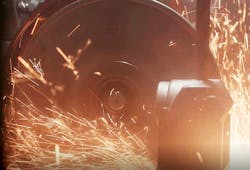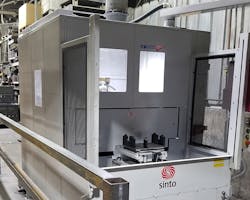A Jobbing Foundry Joins the Shift to Automated Grinding
Foundries’ shift to automated grinding has accelerated in the past decade for a range of important reasons. Manual grinding is a punishing assignment and finding workers who are willing to undertake it is increasingly difficult. But consider too that automated grinding has become increasingly effective and reliable, not just for high-value castings that must conform to buyers’ rigid specs but also for high-volume production, in which case the rate of completion for the beleaguered manual grinder cannot keep up with the workflow.
Seneca Foundry, in Webster City, IA, is a ready example of the growing trend toward automated grinding. Seneca was established over 110 years ago and operates today as a job shop, mainly producing gray and ductile iron castings.
Prior to a recent capital investment, Seneca Foundry workers were manually grinding all the castings produced there -- and the business had a shortage of labor in the cleaning room. It was time to make the change to an automated grinding system. The research began into the options available for grinding systems that would work best for the operation.
"When Seneca Foundry was looking into investing a machine that automated grinding, we were looking for a machine that was easy to program, easy to change over, and offered flexibility," recalled sales engineer Jeff Vorhies. The choice settled on Sinto America’s purchased a X7i-FDH22R-455GR-C Barinder – a high-speed, automated grinder that the developer noted dramatically reduces finishing time and labor costs.
"One of the reasons that we decided to go with the Sinto brand was the ease of programmability of the machine. We are able to program and develop fixtures for each one of our part numbers," according to Seneca Foundry president Lori Mason.
The Barinder's easy-to-learn programming is designed to be intuitive and allows the operator to teach the machine to perform automatically the same operations that otherwise would be performed manually. "With Sinto, you don't have to have a programming degree or have gone to college. It is pretty simple. We did three days on-site training … and just from that little bit of time we have not had any issues with programming. We have not come across any real difficulties that we could not get past," confirmed process engineer Alex Brown.
The X7i-FDH22R-455GR-C automatic grinding-deburring machine is designed for handling small- to medium-sized castings, but it’s also suitable for grinding interior and exterior surfaces of complex castings. It is capable of quick change-out for its selection fixtures and tools, as well as activation for grinding programs (in less than five minutes, according to Sinto.)
The simple programming and operation emphasized by Seneca Foundry’s operators is a feature that contributes to the system’s maximum-uptime potential.
The machine operates with a two-position servo pallet changer, for reliable and consistent use. A rotating main diamond wheel operates in coordination with a pivoting, small-diamond pencil tool. The diamond tools offer long service life, to conserve operating costs, and at the same time minimize the potential for dust generation. Pencil tools are available in various optional configurations.
Other options available for the Barinder grinder include an air cooler, complete robotic loading/unloading integration, and vision systems that can be applied to maximize throughput and minimize labor requirements. In all, the developers emphasize the system’s high-speed and high-efficiency that support high productivity and high-quality finishing.Seneca Foundry confirmed the claims. Over the past year of operation, the Iowa company has found the benefits of the Barinder Grinder have verified their choice and the purchase. Using the Barinder, the foundry is able to grind castings automatically in half the time it would take to complete the task by traditional hand grinding. "You know the machine sets the pace, so when an operator is working on a casting, setting the fixture in and it’s ready to go- production wise we've seen more of a leveling," Lori Mason said.
In addition, the ease of programming and flexibility for set-up are assets to a jobbing foundry. "The bottom line of Seneca Foundry has definitely been positively impacted by the Barinder,” she confirmed. “The safety aspects of it, the ease of training for operators, and programming multiple parts to get the job done quicker has helped us to reduce some of our overall operating costs.
“And, the Barinder has allowed us to be more consistent in the product we give to the customer from a quality aspect," she concluded.

